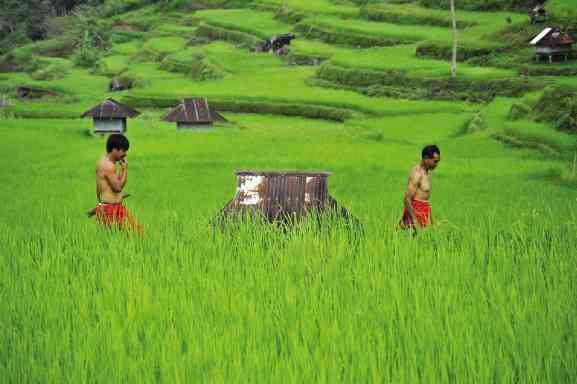Redeeming the lost glory of brown rice

THE RICE TERRACES of Natonin town in Mt. Province grow “kintoman,” one of the varieties sought in the market for its health benefits. EV ESPIRITU
Time was when Filipinos cooked and ate brown rice because the only method to remove the husk of palay was by pounding it with a wooden pestle and mortar or a stone grinder.
Starting in the 1950s, when modern rice milling machines were first introduced, many Filipinos shifted to eating well-milled white rice, displacing brown rice, derisively called “dirty rice,” from the dining table.
In 2000, Asia Rice Foundation revived the interest for brown rice by promoting it as a healthier alternative to white rice.
While the fight to redeem the lost glory of brown rice seems uphill, government agencies are not stopping research and development activities to sustain this variety in the fields and markets.
“We are tirelessly promoting brown rice as a health food. We go on television, radio, the Internet, setting up billboards, putting up exhibits and other activities to drum up consciousness and support for brown rice,” says Hazel Antonio, a staff member of the Philippine Rice Research Institute (PhilRice) and head of the Department of Agriculture’s “Be RICEponsible” campaign.
Article continues after this advertisementUnhusked grain
Article continues after this advertisementDr. Marissa Romero, food scientist at PhilRice’s rice chemistry and food service division and head of research and development for brown rice, says the difference between brown and white rice rests on the processing of the unhusked grain.
The rice grain or seed is composed of the hull or husk, the endosperm and the embryo. The hull is the grain’s hard cover, while the endosperm, which is composed of starch, sugar, protein and fats, is the storehouse of the embryo.
Also called germ, the embryo is where the shoots and roots are developed when conditions for their development are met. The bran gives the grain a healthy dose of oil and fiber.
In producing brown rice, only the husk or the outer layer is removed. When it is polished to produce white rice, the bran layer and other compounds associated with the embryo are removed.
PhilRice says white rice is just refined starch without the original nutrients of the rice grain.
Health benefits
Frequent consumption of brown rice may reduce the incidence of cardiovascular diseases such as hypertension, hypercholesterolemia (a condition where high levels of cholesterol are found in the blood) and stroke, Romero says.
The chances of getting cancer and diabetes, she says, may also be reduced by eating brown rice.
“Whiter doesn’t always mean better,” Romero says. “Brown rice is even more delectable in goto and lugaw (porridge).”
Brown rice includes pigmented rice varieties and may be purplish brown, red or violet. Among the more popular pigmented rice are the Tapul, Balatinaw, Calatrava, Dinorado, Kabankalan, La Castellana and Malido. These are mostly traditional rice varieties, usually found in the highlands.
Romero says sprouting brown rice is even more desirable. Sprouted brown rice (“togeng bigas”) has gamma-aminobutyric acid
(Gaba), which is about 10 times the level found in white rice. It is anticancer and good for brain metabolism. It also contains fiber, which is good in managing constipation and in fighting colon cancer plus other nutrients.
A germination process that enhances the health-promoting properties of brown rice has been developed by a PhilRice study. The process, she says, involves soaking the rice in water for 12 hours, draining and wrapping it in cheesecloth for 24 hours.
The resulting germinated brown rice (GBR) can be cooked as alternative to white rice or as an ingredient in food products.
A beverage of GBR with carabao milk, called “Nutri Rice Milk” has also been developed by PhilRice. The product is a good source of protein, fiber, iron and calcium, the agency’s officials said.
PhilRice is also addressing concerns that brown rice has become unappealing due to its price, sold at P45 to P50 per kilogram, and its texture, taste and shorter shelf life, Antonio says.
According to PhilRice researchers, the supply of brown rice is low due to lack of milling facilities.
Antonio says the Philippine Center for Postharvest Development and Mechanization (PhilMech) is pilot-testing a mill for brown rice so the grain’s price can be lowered.
Recently, PhilRice officials led a “Brown Rice Day” in Isabela province to promote the grain.
Democrito Rebong II, PhilRice Isabela branch manager, says more Filipinos should eat brown rice to promote a healthy lifestyle and to support local farmers. With a report from Villamor Visaya Jr.